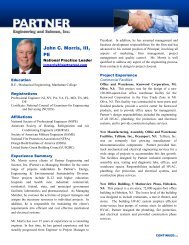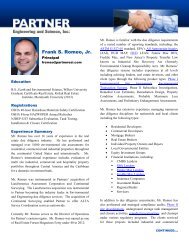Use of California Human Health Screening Levels (CHHSLs) in ...
Use of California Human Health Screening Levels (CHHSLs) in ...
Use of California Human Health Screening Levels (CHHSLs) in ...
You also want an ePaper? Increase the reach of your titles
YUMPU automatically turns print PDFs into web optimized ePapers that Google loves.
the lookup tables for sites with other land uses (e.g., agriculture, parkland, etc.)should be discussed with and approved by the oversee<strong>in</strong>g regulatory agency.2.2 Develop<strong>in</strong>g a Conceptual Site ModelThe primary condition for use <strong>of</strong> <strong>CHHSLs</strong> is that exposure pathways <strong>of</strong> concernand conditions at the site match those taken <strong>in</strong>to account <strong>in</strong> the development <strong>of</strong>the <strong>CHHSLs</strong>. Thus, it is always necessary to develop a conceptual site model(CSM) to identify likely contam<strong>in</strong>ant source areas, exposure pathways, andpotential receptors to determ<strong>in</strong>e the applicability <strong>of</strong> <strong>CHHSLs</strong> at the site and theneed for additional <strong>in</strong>formation. The conceptual site model summarizes<strong>in</strong>formation about site conditions <strong>in</strong> a schematic presentation <strong>in</strong> terms <strong>of</strong>: 1)primary sources (e.g., leak<strong>in</strong>g tanks); 2) secondary sources (e.g., contam<strong>in</strong>atedsoil); 3) contam<strong>in</strong>ant transport mechanisms (e.g., volatilization and <strong>in</strong>trusion <strong>in</strong>tobuild<strong>in</strong>gs); 4) contam<strong>in</strong>ated exposure media (e.g., <strong>in</strong>door air); and 5) potentiallycomplete exposure pathways.The CSM can be used to provide a rationale for additional site <strong>in</strong>vestigation, as abasis for a more detailed CSM, and/or to select screen<strong>in</strong>g levels or cleanup levelsfor specific environmental concerns. An example model is shown <strong>in</strong> Figure 2-1.The example model represents a hypothetical release <strong>of</strong> petroleum-based fuelsand pesticides to soil and groundwater at a large hous<strong>in</strong>g redevelopment projectwith open spaces accessible to residents (direct exposure), enclosed build<strong>in</strong>gs(vapor <strong>in</strong>trusion), wetlands (ecotoxicity) and communal garden areas where fruitsand vegetables are grown (uptake <strong>in</strong> edible plants). Potential environmentalconcerns at the hypothetical site are identified by a check mark <strong>in</strong> the appropriatecolumn. In addition, xylene and other compounds <strong>in</strong> petroleum <strong>of</strong>ten cause odorand aesthetic concerns (nuisances). Cleanup to address these and other grosscontam<strong>in</strong>ation concerns may be required even after all other potential concernshave been adequately addressed.If completed exposure pathways at a site match those pathways considered <strong>in</strong> thedevelopment <strong>of</strong> the <strong>CHHSLs</strong>, the appropriate soil and soil gas data can be directlycompared to the <strong>CHHSLs</strong> to determ<strong>in</strong>e if the magnitude <strong>of</strong> exposure may pose apotential threat to human health. If the exposure pathways at a site do not matchthose pathways used <strong>in</strong> the development <strong>of</strong> the <strong>CHHSLs</strong>, these screen<strong>in</strong>g levelsmay not be used, and a site-specific human health risk evaluation should beperformed.January 20052-2CHHSLS















